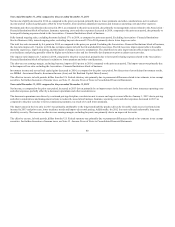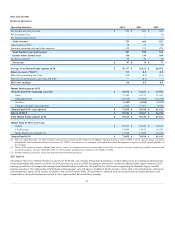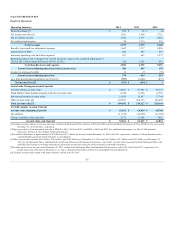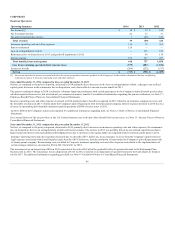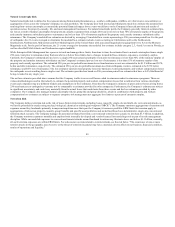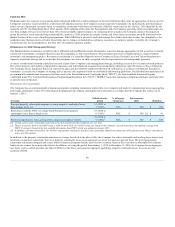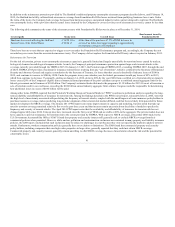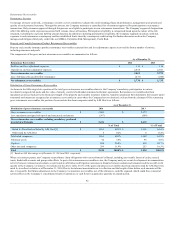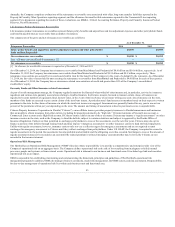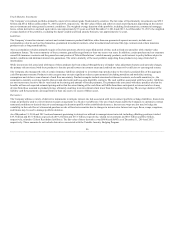The Hartford 2014 Annual Report Download - page 89
Download and view the complete annual report
Please find page 89 of the 2014 The Hartford annual report below. You can navigate through the pages in the report by either clicking on the pages listed below, or by using the keyword search tool below to find specific information within the annual report.
Natural catastrophe risk is defined as the exposure arising from natural phenomena (e.g., weather, earthquakes, wildfires, etc.) that create a concentration or
aggregation of loss across the Company's insurance or asset portfolios. The Company uses both internal and third-party models to estimate the potential loss
resulting from various catastrophe events and the potential financial impact those events would have on the Company's financial position and results of
operations across the property-casualty, life, and asset management businesses. For natural catastrophe perils, the Company generally limits its estimated pre-
tax loss as a result of natural catastrophes for property & casualty exposures from a single 250-year event to less than 30% of statutory surplus of the property
and casualty insurance subsidiaries prior to reinsurance and to less than 15% of statutory surplus of the property and casualty insurance subsidiaries after
reinsurance. The Company's modeled loss estimates are derived by averaging 21 modeled loss events representing a 250-year return period loss. For the peril
of earthquake, the 21 events averaged to determine the modeled loss estimate include events occurring in California as well as the Northeastern,
Southeastern, Northwestern, Midwestern and New Madrid regions of the United States with associated magnitudes ranging from 6.0 to 8.2 on the Moment
Magnitude scale. For the peril of hurricane, the 21 events averaged to determine the modeled loss estimate include category 2, 3, 4 and 5 events in Florida, as
well as other Gulf, Mid Atlantic and Northeastern region landfalls.
While Enterprise Risk Management has a process to track and manage these limits, from time to time, the estimated loss to natural catastrophes from a single
250-year event prior to reinsurance may fluctuate above or below these limits due to changes in modeled loss estimates, exposures, or statutory surplus.
Currently, the Company's estimated pre-tax loss to a single 250-year natural catastrophe event prior to reinsurance is less than 30% of the statutory surplus of
the property and casualty insurance subsidiaries and the Company's estimated pre-tax loss net of reinsurance is less than 15% of statutory surplus of the
property and casualty operations. The estimated 250 year pre-tax probable maximum losses from hurricane events are estimated to be $1.5 billion and $570,
before and after reinsurance, respectively. The estimated 250 year pre-tax probable maximum loss from earthquake events is estimated to be $736 before
reinsurance and $471 net of reinsurance. The loss estimates represent total property losses for hurricane events and property and workers compensation losses
for earthquake events resulting from a single event. The estimates provided are based on 250-year return period loss estimates that have a 0.4% likelihood of
being exceeded in any single year.
The net loss estimates provided above assume that the Company is able to recover all losses ceded to reinsurers under its reinsurance programs. There are
various methodologies used in the industry to estimate the potential property and workers compensation losses that would arise from various catastrophe
events and companies may use different models and assumptions in their estimates. Therefore, the Company's estimates of gross and net losses arising from a
250-year hurricane or earthquake event may not be comparable to estimates provided by other companies. Furthermore, the Company's estimates are subject
to significant uncertainty and could vary materially from the actual losses that would arise from these events and the loss estimates provided by other
companies. The Company also manages natural catastrophe risk for group life and group disability, which in combination with property and workers
compensation loss estimates are subject to separate enterprise risk management net aggregate loss limits as a percent of enterprise surplus.
The Company defines terrorism risk as the risk of losses from terrorist attacks, including losses caused by single-site and multi-site conventional attacks, as
well as the potential for attacks using nuclear, biological, chemical or radiological weapons (“NBCR”). The Company monitors aggregations of terrorism risk
exposure around key landmarks primarily in major metropolitan areas that span the Company's insurance portfolio. ERM limits for terrorism apply to
aggregations of risk across property-casualty, group benefits and specific asset portfolios and are defined based on a deterministic, single-site conventional
terrorism attack scenario. The Company manages its potential estimated loss from a conventional terrorism loss scenario to less than $1.3 billion. In addition,
the Company monitors exposures monthly and employs both internally developed and vendor-licensed loss modeling tools as part of its risk management
discipline. While our modeled exposures to conventional terrorist attacks around landmark locations may fluctuate above and below $1.3 billion, currently,
all such terrorism exposures are within ERM limits. For a discussion on risks related to terrorist attacks, see the risk factor, "The occurrence of one or more
terrorist attacks in the geographic areas we serve or the threat of terrorism in general may have a material adverse effect on our business, financial condition,
results of operations and liquidity."
89



